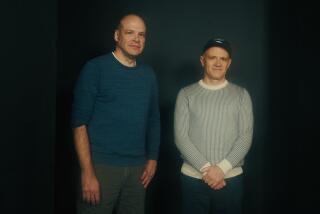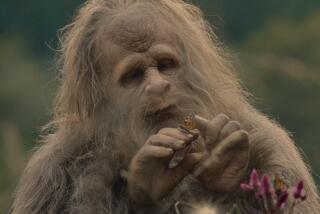Bigfoot? He’s not so elusive
- Share via
Imagine a hulking, growling, 8-foot-tall woodland creature so elusive that professional trackers can’t find it, scientists can only speculate about it and believers can’t prove -- definitively -- that it exists.
Hiding deep in the forest may be your modus operandi, Bigfoot, but Hollywood and Madison Avenue are pushing you -- however reluctantly -- into the spotlight. A slew of documentary, TV and film projects including Animal Planet’s current hit “Finding Bigfoot,” and a Sasquatch film trilogy from “Blair Witch Project” director Eduardo Sanchez are poised to get past the old grainy images of yesterday and give the hairy 800-pound biped a high-def close-up.
“There’s been a real upswing in scholarly interest along with this huge undercurrent of popularity among the general public,” said Jeffrey Meldrum, the Idaho State anatomy and anthropology professor and primates expert who wrote “Sasquatch: Legend Meets Science” as a companion to a Discovery Channel special of the same name. “There’s something about the human psyche that really connects with this icon.”
Campfire stories, eyewitness reports and grainy videos have kept the legend alive for decades in the U.S. and worldwide. (The mythology goes back much further if you take cave drawings into account.) And Bigfoot has been a pop culture fixture since the 1950s, popping up in movies, commercials and as a guest on ‘70s TV hits like “The Six Million Dollar Man” and “The Bionic Woman.”
Each time there’s a new development -- such as evidence of a yeti allegedly uncovered in Russia last fall or a Bigfoot body purportedly discovered in Georgia, both of which turned out to be fake -- there’s a spike in online searches, blog posts, news reports and, inevitably, Bigfoot-centric entertainment.
“Blair Witch’s” Sanchez is working on a Bigfoot-based horror movie, the first of a planned trilogy, and a group of Bigfoot enthusiasts is putting together a documentary called “Sasquatch: The Quest.” Meldrum, along with launching an online scholarly journal, is producing an Internet TV project and considering an expanded version of “Legend Meets Science.”
“We all want to believe that there are still monsters lurking in the secret corners of the planet, and that’s the allure of Bigfoot,” said Marjorie Kaplan, president of Animal Planet, home to the hit series “Finding Bigfoot. “It’s fun to be reminded that we don’t know everything.”
“Finding Bigfoot” follows four eccentric field researchers who travel to towns where there have been sightings, gather stories from the locals and set out on their own expeditions. The colorful characters have coined “squatch” as a term of endearment and say things like “It’s really squatchy out here,” to describe remote areas they think are harboring Bigfoots.
The series, which attracted 1.6 million viewers for its second season premiere, will launch its third season this summer. “If anybody’s going to find him, it’s going to be us,” Kaplan declared, adding with a laugh, “hopefully after 100 episodes.”
In coming months, cable TV will be overrun with Sasquatch programming. Syfy thriller “Bigfoot” promises a “big and nasty, teeth and claws” star nestled in a kitschy popcorn flick, according to Thomas Vitale, the network’s executive vice president of programming. Airing this summer, the Saturday night movie pits former child stars Barry Williams and Danny Bonaduce against each other in a search for the larger-than-life biped at a rural music festival. It fits strategically with the network’s tradition of over-the-top original action movies like “Sharktopus” and “Piranhaconda.”
“Bigfoot is a classic trope of the creature feature,” Vitale said. “It’s a story that spans a lot of cultures ... and it’s ripe for reinvention.”
TV has been doing exactly that by using Bigfoot in purely fictional, and sometimes goofy, ways in series such as Disney Channel’s “Phineas and Ferb” and Nickelodeon’s “iCarly,” not to mention frequent reruns of the ‘80s family comedy film “Harry and the Hendersons.”
In “iBelieve in Bigfoot,” the “iCarly” kids head into the woods looking for the creature in what executive producer Dan Schneider said is one of the series’ most popular episodes to date. The youngsters never actually see Bigfoot, but they hear a menacing growl as they see their RV drive away, leaving them stranded.
“The implication is that Bigfoot’s real, and he’s also a car thief,” Schneider said.
It’s a kid-relevant subject because “every generation discovers the Bigfoot legend, sort of like discovering the Beatles,” said Dan Povenmire, one of the creators of the animated “Phineas and Ferb.” He and partner Jeff “Swampy” Marsh wrote an episode called “Get That Bigfoot Outta My Face,” that sprang from their own childhood memories of hearing scary stories and seeing the famous 1967 Patterson footage of a purported Bigfoot in Northern California.
Even commercials have fun using Bigfoot as a punch line: A current ad for Stride Whitemint gum stars Olympic medalist Shaun White and a yeti who socks a guy in the gut so he’ll spit out his long-lasting chewing gum and replace it with another.
At the more serious end of the spectrum are interview-based docu-style shows such as History’s “Bigfoot: The Definitive Guide,” National Geographic’s “Is It Real?” and Syfy’s “Destination Truth.” Travel Channel’s “Legends of the Ozarks” and “Bigfootville” will poke around in isolated areas for Bigfoot evidence in episodes airing in late March.
Cliff Barackman, an elementary school teacher and cast member on “Finding Bigfoot,” said a TV series dedicated to Sasquatch hunting was “long overdue.”
“When there are multiple shows about cakes and ghosts, why not a show about Bigfoot?” Barackman said. “Our show reinforces the fact that we’re looking for a species, not an individual, and that we’re trying to help people understand what a Bigfoot might actually be.”
--


